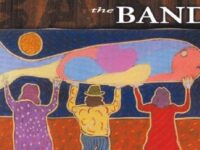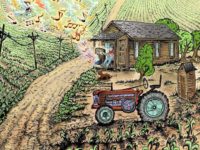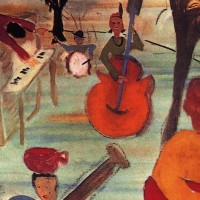They wouldn’t have happened if Garth Hudson hadn’t thought to plugged in a tape machine. And they wouldn’t have been issued if he hadn’t zealously guarded those reels for decades.
As fans delve into the six-disc compendium of rough-hewn drama, quickly emerging genius and goofball fun that is The Basement Tapes Complete: The Bootleg Series Vol. 11, Hudson generously shares credit with archivist Jan Haust, with restorationist Peter J. Moore, with Bob Dylan, and with his friends in the Band. But, from the first, it was Hudson’s own fastidious attention to detail — his numbering system was used to sort out the songs’ chronological order for this box set — that made the wonder of The Basement Tapes tangible to anyone who wasn’t part of those loose sessions in West Saugerties, N.Y., in the summer of 1967.
Otherwise, all of this would have been lost to the ages: Their earliest, embryonic turns on shared cover songs, like exercising to muscle memory. Their first collaborative triumphs. Their deeper dives into the music that consumed them as youths, and sparked them as young artists. The construction of a bridge between Dylan’s frenetic Blonde on Blonde era and his more rustic John Wesley Harding, and from the Band’s randy days as the Hawks to their genre-creating roots-rock debut Music from Big Pink.
None of it was planned, as they gathered in this most rudimentary of places — the basement of an old farmhouse, dubbed Big Pink because of its outlandish paint job — and thus could just as easily have gone unremembered. That’s where Hudson came in, with his quarter track Ampex machine.
“There would be an informal discussion, before each recording,” Hudson tells us, in an exclusive Something Else! Sitdown. “There would be ideas floating around, and the telling of stories. And then we’d go back to the songs. It was very down to business for everybody. There wasn’t much of a desire to jam out, like playing a 12-bar blues. We never slowed down. I was just thinking, did we have a television? I don’t remember a television in Big Pink. I do remember that we had radios and the record player.”
Together, they slowly found new voices. It came evening by evening, conversation by conversation, track by track. “We made a more concerted effort at writing songs, and the study of literature,” Hudson says. “We looked for words, phrases and situations that were worth writing about. I think that Bob Dylan showed us discipline, and ageless concern about the quality of his art.”
At first, Dylan was working with Garth Hudson, Robbie Robertson, Rick Danko and Richard Manuel. Levon Helm, who didn’t take part in Dylan’s ground-breaking electric tours, wouldn’t rejoin them until late in the proceedings. And so, The Basement Tapes Complete: The Bootleg Series Vol. 11 also works as a secondary showcase for the multi-instrumental prowess of Manuel, who played both piano and drums.
“His piano work is a study in itself,” Hudson says. “Richard was the finest of the energy-accompaniment players, and behind all of the tapes — almost all of The Basements Tapes — you will hear Richard Manuel’s piano. Levon said once that Richard Manuel was his favorite drummer. He played very well on songs like ‘Rag Mama Rag’ [from 1969’s The Band], and he did it playing backwards. He moved the snare to the other side. He was like the main percussionist, during the time when Levon was not there, and his rhythm and steadiness and natural flair for percussion carried over into piano.”
Meanwhile, Hudson always had an eye on the future, even as these boisterous sounds emerged. “It was a quarter track machine, meaning it had two tracks one way and then you turned it over and there were two tracks the other way,” Hudson says, “so leakage from one track to the next is possible. I think on most of the tapes, I only recorded in one direction. The basement had these cement-block walls, so there was some discussion about putting blankets up to deaden sound. But it actually helped the sound of the instruments in a way, having a hard surface.”
He then carefully stored the reels for years, even creating a specially designed pine box. “There was careful handling — but there wasn’t really much water damage,” Hudson says. “Some times with older tapes, you have to bake them and then you can only hope to play them only one or two times if they’re that bad off. But this collection was not in that kind of shape.”
Of course, all of that care couldn’t completely shield these precious artifacts from time. Some of The Basement Tapes disappeared. There was the story in which Danko inadvertantly recorded over one of them. Another reel was reportedly lost for years when it went on loan to Dylan’s people. They’d remember something from those times, and wonder what became of it.
“It was funny,” Hudson tells us, “Bob called me on the phone a year or two later and said: ‘Did you ever find [a legendary unfinished demo] called ‘Can I Get A Race Horse’? I remember him playing a riff, a guitar riff [Hudson hums it], something like that with a Bo Diddley beat. I remember we recorded the thing, and I think we must have gone over it. It was just an introduction. I’d really like to hear it again. He was doing it on the guitar. But I couldn’t find it.”
It was only when the idea of releasing all of the salvageable recordings from this era, nearly 50 years after they were first made — and almost 40 after a single-disc version appeared in 1975 — that Garth Hudson returned to the reels in earnest. Along with Haust and Co., they dove into cataloging and remastering, as if the ensuing decades had never happened.
What Hudson heard, beyond Dylan’s rebirth after a motorcycle accident sent him into a lengthy seclusion, was the Band coming into its own. Living together, living this music, created a deep musical bond.
“We started to develop the three-part harmony, to see which goes on top and what section they would add harmonies to — the whole arranging part of it,” Hudson says. “Singing the harmonies together, we had to pay attention. It had to be safe. We approached the whole experience with caution. I think everyone anticipated a chord, and they could move into it very quickly. You get to be very swift; a millisecond after you hear something, you can chime in or lay out. We knew how not to infringe on one’s personal endeavor, while living in the same structure.”
Constructing The Basement Tapes Complete: The Bootleg Series Vol. 11 offered this stalwart member of the Band a rare opportunity — to experience these things in a new way, and that extended even into his own contributions. “Now that I look back, and I have my favorites in there. I think the some of the best writing was in ‘Yazoo Street Scandal.’ That really does create an atmosphere. I liked the piece; that was one of Robbie’s finer pieces,” Hudson says, before adding with a chuckle: “Of course, some of the things I did, I wasn’t aware of until recently just how appropriate they were. The lines were well spoken musically, so I was happy to hear that I did a good job.”
Mostly, however, he marvels over how present and dynamic these remasters sound. “I hadn’t listened to them since that time — before 1975,” Hudson tells us. “They were regarded as special and treasured. But we had no idea that modern technology would make the voices clearer and improve the overall sound of the instruments. I’m really happy with this work. Thanks to Mr. Haust, who always had the highest standards in mind.”
- How Deep Cuts on ‘Music From Big Pink’ Underscore the Band’s Triumph - July 31, 2023
- How ‘Islands’ Signaled the Sad End of the Band’s Five-Man Edition - March 15, 2022
- The Band’s ‘Christmas Must Be Tonight’ Remains an Unjustly Overlooked Holiday Classic - December 25, 2016




